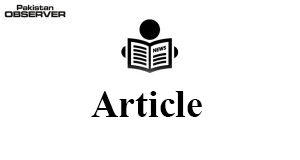Aleena Nazir
PAKISTAN’S most populous city Karachi has suffered its worst rains and floods for nearly a century. Karachi flood affects the huge amount of population and many people die in Karachi each year during monsoon season, which occurs typically in July and August. Due to flood daily life of Karachi population is affected. 1000 homes were also damaged due to 2020 flood in Karachi. Floods bring more than just destroyed property. They increase the chances of disease and illness in the community. By August 29, 2020, the six districts of Karachi have now become “disaster areas.” Many underground water tanks for drinking water have now been turned off. The effects of drinking water restrictions are enormous. So where do people go if there is no fresh water? Unfortunately, they use drinking and using dirty water. Usually, dirty water is stagnant, not flowing from the floodwaters. Standing water attracts mosquitoes that carry diseases such as malaria, diarrhea and hepatitis. Those most vulnerable, such as children, pregnant women, seniors and people with disabilities, are at the highest risk of developing health problems. Dozens of vehicles were found drowning in Karachi. Many of affected people went to the houses of relatives.
According to the data, the 15 billion rupees are required to maintain the Karachi sewage system. Population provides them with 26 billion rupees annually but local officials don’t use them for the city’s development. So who is more responsible of this situation government authorities or population? Residents blamed the authorities for the disaster, saying there was no preparation before the start of the regular rainy season but according to my opinion population is also equally responsible for this flood disaster. So we should need to do proper managements before flood. The tax collected from Karachi is more than the tax collected from Lahore, Rawalpindi, Islamabad and Faisalabad. The tax collection in Karachi was Rs4.45 billion during July-February 2019/20. No one knows where are going these taxes and we could have used these funds in areas with Karachi floods but Karachi faces every year’s floods disasters in different areas which is harmful for population of Karachi and also the economy of Karachi. Flood is not happening recently in Karachi, Karachi has been facing floods situation for the last 30-40 years. This is a repeating story, year after year. This year it is worse.
Road collapses and sewage systems are overflowing and homes are damaged; questions arise as to where the taxpayers’ money went? In the absence of the implementation of Karachi’s development plans, they constructed bazaars and market over nullahs and many other hotels constructed like MPA hotel on nullahs and also household pressure due to the lack of affordable housing for the poor has been steadily increasing in Karachi. We have to make a strong but unhappy decision” to demolish illegal structures. Due to flooding in Karachi, more than three million children are at high risk of deadly water-borne diseases. Flood occurs due to also improper sewage treatment system. The main reason of Karachi floods is overpopulation. It is true that poor drainage and sewage system is the real cause of Karachi flooding. Solid waste and infrastructure blocked the natural flow of storm water. There is a long-term and short-term solution to this problem. In the meantime, drainage cleaning throughout the city is urgently needed. The private sector can come up with a waste management plan as the government does not have the capacity to address this issue.
Construction of sewerage system pipeline is too small; these pipelines do not absorb both rain and surface water at the same time. The Karachi sewer lines, which range from 4 to 60 inches [4 to 60 cm] in diameter, came under considerable pressure during the rainy season as the system was not built or built to carry sewage and rainwater. People observed a few things in America that may be done in Karachi. Rain is a blessing, learn to collect this water, so it may be used later…perhaps several fairly large ponds filled with water and place greenery around these ponds…including several large trees and number of plants with flowers. It can be a great place to visit and enjoy beautiful little lakes surrounded by trees and flowers. In the United States, a city was flooded. The city’s drainage system was not good enough to absorb rainwater, so their pipeline system was as narrow as Karachi’s, and they changed their previous pipeline to reduce flooding. So we can also follow this process to reduce Karachi flooding. Make storage tanks in all parks and open spaces to save rainwater. Collect as much rainwater as possible in open ponds in water storage areas. We should need to develop and implement a wider community awareness programs to inform community with flood hazards as well as flood readiness.
—The writer is working at Sustainable Development Policy Institute (SDPI).










